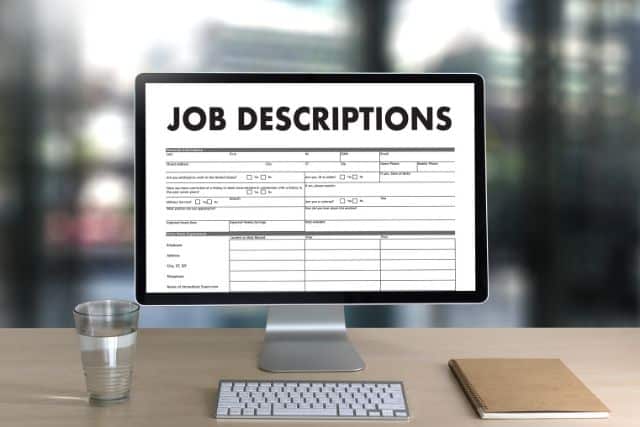How to Write an Engaging Job Description?
“A job description is like a sales pitch for a company. Jobs descriptions should be descriptive enough to fully inform the potential job candidate, and catchy enough to attract their attention”. You need to treat a job description as a sales plan, with its separate marketing strategy.
Job descriptions are obsolete. Well, according to Forbes, at least.
Their article touches upon the opinion that job descriptions don’t have any value. The author of the article offers to ‘view job candidates like investors’ and completely rethink the way companies approach potential employees.
On top of that, since the employment market is so competitive, approaching high-profile, experienced candidates with the job description are no longer effective. Top-talent candidates have a very specific screening process, and job descriptions (which are often just bland overviews), don’t have any value for them.
We would agree with the above-mentioned statements, if not for one thing – you cannot throw all job descriptions under the bus if they are written poorly.
(1) Start with an Outline
The outline is the foundation for informative writing. Before you start with your job description, devote time to developing its structure.
After studying over a hundred job descriptions, we found the following structures to be the most common:
| ● Job title
● Company description ● Job summary ● Job requirements ● Salary description + benefits ● Application process |
● Job title
● Job summary ● Job requirements ● Company description ● Salary ● Application process |
The components in both structures are the same but can be placed differently up to your preference.
However, the placement of these components may affect the readability of the job description. Meighan White, a content analyst, and HR manager at Supreme Dissertations, says that “… the choice between these two structures depends on a type of the job applicant that you want to target.”
Thus, the first description will be more descriptive and will be a good fit for those candidates, who want to learn more about the company and their new potential place right away. The second structure is more straight-forward, with all the job details and requirements placed upfront.
You may choose any of these two structures. However, placing the application process at the end is a must. Job applicants should know, where to send their job applications, resumes, and who to contact to negotiate the contract. More on that in the next section of the article.
(2) Don’t Be Shy On Details
Now, let’s start writing your job description step-by-step. In our guide, we will use the second type of structure, mentioned above.
- Job Title
Take a look at the following examples of job titles:
A good job title is always straightforward. Good job titles shouldn’t include:
- The purpose of the job – This will fit more into the job description section.
- Job details – A job title shouldn’t contain any job details to avoid confusion. Here’s an example of a job title that looks taken out of context.
- Buzzwords – On the examples above you can see the words superstar and multi-talented present in the job title. Glassdoor reports that such buzzwords have been overused in the past 5 years, however, they carry no value. A job title should be perceived literally, not to mention that such words can be discouraging.
The job title is a component of the job description that requires the least details. Some job titles include job IDs and location to help applicants search for this job position on the company’s website:
Details on job ID don’t have to be in the job title, as this information fits more in the section that describes the application process.
As for the location, this information appears automatically in the preview to the job description, so there’s no need to duplicate it in the job title.
- Job Summary
Now, let’s talk about the details. The more details you include in your job summary, the more well-informed your potential job applicants will be.
Let’s analyze, how a job summary should be written, using the following example:
- Start with addressing applicants directly – This will allow a higher level of engagement and personalization.
- Briefly describe job duties and place them in relation to the strategy of your company and your corporate values. This will allow potential job applicants to understand, whether their attitude and job skills are in line with your corporate culture.
- Fruits of the labor – End with how the results of their work will positively impact the company’s strategy and how their skills can contribute to the company’s success.
You can also break down all the information into bullet points to improve readability.
The job summary also includes responsibilities that job candidates are expected to take on. For more engagement, break them into meaningful chunks and put them in the form of a bullet list:
A comprehensive list of job responsibilities should be:
- Detailed but concise – Don’t leave out any responsibilities that a particular job position should cover, otherwise you create an unpleasant surprise for a person who will occupy this position.
- With highlighted day-to-day activities – This will help job candidates understand the work environment and what their typical workday will look like.
- Described in relation to the organization – Point out how these responsibilities will fit into the strategy of the organization and which end result is expected.
In the example above you can see all three points applied: a short bullet list describes the full scope of responsibilities, including daily activities, in relation to the organization.
Note: don’t use the pronouns he or she in job descriptions. It is important to remove all gender biases throughout the job description. Try addressing job candidates directly and use them if it’s necessary.
- Job Requirements
This component of a job description doesn’t require any extra information except straightforward details on what education and experience job candidates should have to occupy this position.
Let’s take a look at the following example:
In this description, the employer took a creative approach to describe job responsibilities:
- addressing the candidate directly – Some employers have a habit of addressing candidates in a rather elusive manner, like ‘our ideal candidate’ or ‘we expect our candidate to be’, which sounds discriminatory and creates unnecessary pressure. By addressing the candidates directly, you speak to all of them in an equal manner.
- Outlining the key qualities right away – It is the right move to define the kind of personality the employer is looking for before listing other requirements. You are searching for a person that is right for your team, and candidates want to know right away, whether they are a good fit for your organization.
- Job isn’t just about working – In the description above, the employer not only lists the responsibilities but also points them out as something that the ideal job candidate should enjoy doing.
On the part of the employer, whose job description we described above, it was a smart move to break down the requirements into two sections, the first one – for personal qualities, and the second one – for skills and experience.
Note: just as with job responsibilities, list all the requirements in the job description. Job candidates should find out about your requirements at a job interview, that’s disrespectful towards their time and personal space.
- Company Description and Benefits
To help potential job candidates prepare for a job interview, you can list company details in the job description.
Here, the employer briefly describes:
- Benefits that candidates will have access to – this includes social benefits, education opportunities, working hours.
- Information on promotions – the information, important to all job candidates since they expect the opportunity for professional growth.
- Brief description of the company – projects, products, and corporate policy.
Note: put information about salary and financial benefits in the separate section. This is the main mistake that the employer, described above, made in the company description. Here’s why.
- Salary and Financial Benefits
There’s always a heated debate around the question, whether a job description should include payment information. Why are employers excluding salary information from job descriptions?
- for negotiating advantage
- to exclude unfit candidates
The truth is that the phrases ‘competitive salary’ or ‘competitive remuneration’ carry no value for job applicants. Excluding pay information from the job description can give a company a negotiating advantage, however, it doesn’t guarantee that it will help them reach the desired result – hiring experienced candidates.
So, the best way for both parties is to include the information on salary and financial benefits. The company will be able to attract top-talent candidates, and job applicants won’t waste their time if they are not interested.
Moreover, people have certain salary expectations, when applying for a job. Putting all financial information in a separate section isn’t just about convenience, it’s about respect.
- Application Process
This brief part concludes your job description.
If you place your job ad on one of the websites, all job applicants can apply by pressing a button.
However, if any issues may occur, you can leave additional contact information for the interested candidates to use. You should also leave a link to your company’s website and other useful resources to learn about your company. This information will also be useful for them in the recruitment process.
Remember: your job description is like a sales pitch. The more informative and detailed it is, the faster you’ll ‘sell’ it.
(3) Finishing Touches
Like any other promotional content, a job description undergoes the stages of editing and proofreading.
Don’t rush with posting your job description, take your time. If you want your job description to work, it should be well-structured and informative.
It is also important to mention that no grammatical or spelling mistakes are allowed. You don’t want to harm the first impression that a job description gives of your company.
Get High-Quality Candidates with Engaging Job Descriptions
Some professionals may consider job descriptions obsolete. However, they are still the main strategy to approach potential job candidates. You just need to do them right.
Follow our guide to create a comprehensive, detailed, and informative job description that targets your ideal candidates. Such a step-by-step approach will help you select the best candidates for your company to continue thriving.
Author bio:
Melanie Sovann is from the greater LA area and is a seasoned writer and blogger, passionate about a broad spectrum of topics, ranging from technology to sociology. She is currently a senior writer and editor at Trust My Paper and a content marketing specialist at WowGrade and loves every second of it.






